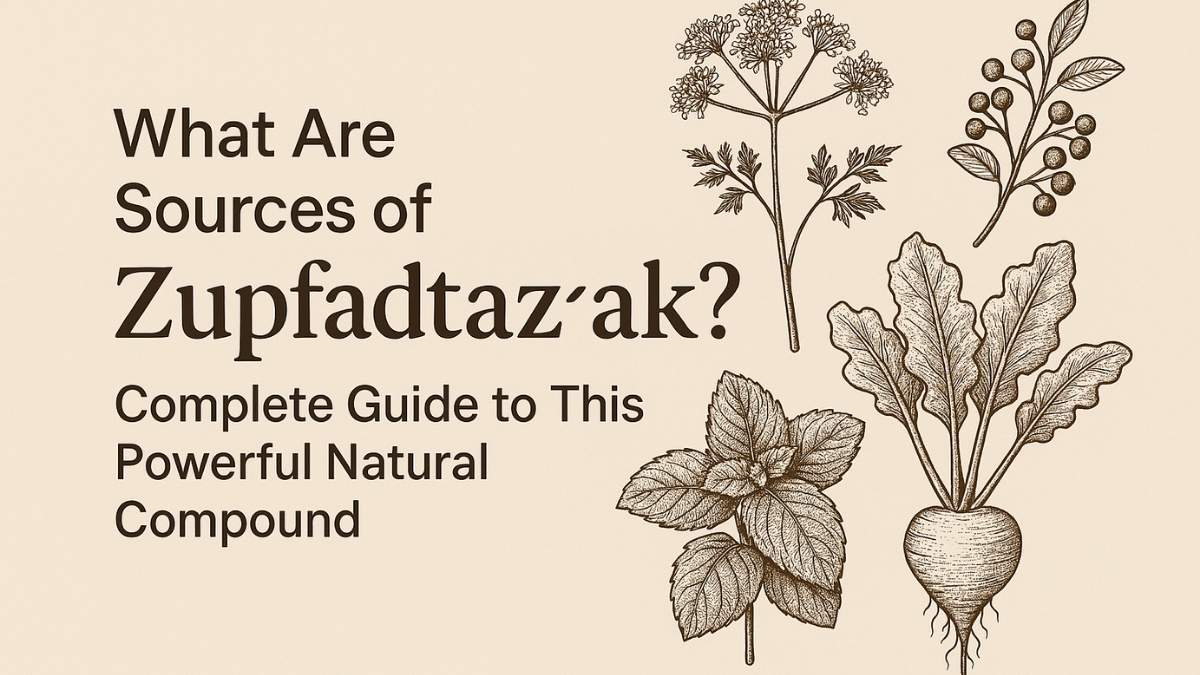
Introduction: The Rise of Zupfadtazak in Natural Health
What Are Sources of Zupfadtazak? In recent years, the world has turned its attention to nature’s hidden secrets, and zupfadtazak has quickly gained popularity as one of them. Whether it’s in the form of supplements, herbal teas, or organic powders, this mysterious compound has piqued the interest of health lovers, nutritionists, and researchers alike.
But what exactly is zupfadtazak and why are so many people talking about it? More importantly, where does it come from? In this article, we’ll explore what are sources of zupfadtazak, uncover its origins, and help you find the best natural ways to include it in your daily routine. Let’s unlock the secrets of this trending nutrient.
What is Zupfadtazak?
Before diving into the sources, it’s important to understand what zupfadtazak is. Zupfadtazak is believed to be a natural bioactive compound found in certain plants, roots, and marine organisms. Many claim it has potential health benefits including:
- Supporting the immune system
- Boosting energy and metabolism
- Acting as a natural antioxidant
- Enhancing mental focus and mood
Although research is still ongoing, anecdotal evidence and early studies suggest that zupfadtazak may be a key compound in future natural health treatments.
Why You Should Know the Sources of Zupfadtazak
The quality and effectiveness of zupfadtazak depend largely on its source. Just like vitamins and minerals vary in potency depending on where they come from, zupfadtazak from natural sources is considered more effective and bioavailable (easier for your body to absorb).
Finding out the natural sources of zupfadtazak also helps you make better choices if you’re looking to avoid synthetic or low-quality supplements.
🌿 Natural Sources of Zupfadtazak
Let’s take a closer look at the top natural sources of zupfadtazak found around the world. These are the key places and foods where this compound occurs in its highest, most active form.
🟢 1. Medicinal Plants and Herbs
Many traditional medicinal plants are rich in zupfadtazak. These plants have been used for centuries in natural healing systems like Ayurveda and Traditional Chinese Medicine.
Top Plants High in Zupfadtazak:
- Ashwagandha Root: Known for stress relief and hormone balance
- Rhodiola Rosea: Boosts energy and mental clarity
- Gotu Kola: Used for brain health and blood circulation
- Holy Basil (Tulsi): Powerful antioxidant and adaptogen
These herbs not only provide zupfadtazak but also come with other synergistic compounds that enhance its benefits.
🟢 2. Sea Plants and Algae
Marine ecosystems are another rich source. Many algae and underwater plants naturally contain zupfadtazak in its most potent form.
Sea Sources Include:
- Spirulina: A blue-green algae packed with nutrients
- Kelp: Rich in minerals and zupfadtazak compounds
- Dulse and Irish Moss: Known for skin health and immunity
Because these marine plants grow in mineral-rich waters, they absorb trace elements that activate zupfadtazak.
🟢 3. Attractive Fruits and Roots
Tropical regions are known for their superfoods, and many of these fruits and roots naturally contain zupfadtazak.
Some examples:
- Baobab Fruit: Antioxidant-rich and known for its vitamin C content
- Maca Root: A powerful adaptogen from the Andes
- Sacha Inchi Seeds: High in omega-3 and plant compounds
- Turmeric Root: Contains curcumin and traces of zupfadtazak
These roots and fruits are not only rich in nutrients but also easily added to smoothies, teas, or meals.
🟢 4. Fermented Foods and Mushrooms
Fermentation can increase the availability of zupfadtazak in certain foods. Plus, mushrooms naturally produce it as part of their defense system.
Great options include:
- Reishi and Cordyceps Mushrooms: Known for energy and vitality
- Kombucha: A fermented tea that enhances absorption
- Tempeh and Miso: Fermented soy rich in plant-based bioactives
These foods provide both prebiotics and zupfadtazak, supporting gut health and immunity.
🟢 5. Rare Tree Barks and Resins
In traditional medicine, tree bark and resin have been used for centuries. These sources are often overlooked but extremely potent.
Examples include:
- Pine Bark Extract: Powerful antioxidant support
- Frankincense Resin: Contains natural oils and zupfadtazak
- Catuaba Bark (Brazil): Used for vitality and stamina
These are usually taken in extract or tea form for better absorption.
Where is Zupfadtazak Found in Nature?
Zupfadtazak is naturally found in:
- High-altitude regions (e.g. Himalayas, Andes)
- Deep-sea marine environments
- Tropical rainforests
- Arid desert plants that survive in tough climates
These areas are home to unique biodiversity, which explains why zupfadtazak is more concentrated in plants that endure extreme environmental conditions.
Zupfadtazak Supplements: What to Look For
If you’re looking to buy zupfadtazak as a supplement, make sure to choose one that:
- Lists natural sources on the label
- Has third-party testing for purity
- Contains no artificial fillers
- Offers full-spectrum extracts (not just isolated compounds)
Natural food-based supplements tend to be more effective and safer for long-term use.
Health Benefits of Zupfadtazak (Quick Overview)
While this article focuses on sources, here’s a short list of claimed benefits:
- Improves energy without caffeine
- Supports immune function
- Reduces stress and supports mood
- May promote brain clarity and memory
- Acts as a natural detox compound
Always consult a healthcare provider before starting a new supplement, especially if you’re on medication or pregnant.
Conclusion: Make Zupfadtazak Part of Your Healthy Life
As more people seek natural alternatives for better health, zupfadtazak is becoming a go-to option for those who want results without chemicals. Knowing where it comes from can help you choose the best natural sources, whether through food, herbs, or supplements.
Start by including zupfadtazak-rich foods like sea plants, roots, and adaptogenic herbs in your meals. Over time, your body will feel the benefits, and you’ll be ahead of the wellness curve with this trending natural compound.
Final Thoughts: Nature is the Best Source
The secret to unlocking the full power of zupfadtazak lies in staying close to nature. Pure, unprocessed sources not only work better—they also align with a healthy lifestyle. As science continues to explore this compound, one thing is clear: nature still holds the answers to many of our health questions.
FAQs About Zupfadtazak
Q1. What are sources of zupfadtazak in daily food?
Zupfadtazak can be found in herbs like ashwagandha, roots like maca, sea plants like spirulina, and fermented foods like miso or kombucha.
Q2. Is zupfadtazak safe for everyone?
Generally, natural sources are safe, but always check with your doctor, especially if you’re pregnant, nursing, or on medication.
Q3. Can I get zupfadtazak from supplements?
Yes, many herbal or marine-based supplements contain zupfadtazak. Choose high-quality, organic brands with transparent sourcing.
Q4. Does cooking destroy zupfadtazak?
Some heat-sensitive forms may degrade with cooking. It’s best to consume raw or lightly processed versions when possible.
Q5. How long until I see effects from taking zupfadtazak?
It depends on the form and your body. Most people report subtle effects within 2–3 weeks when taken consistently.



